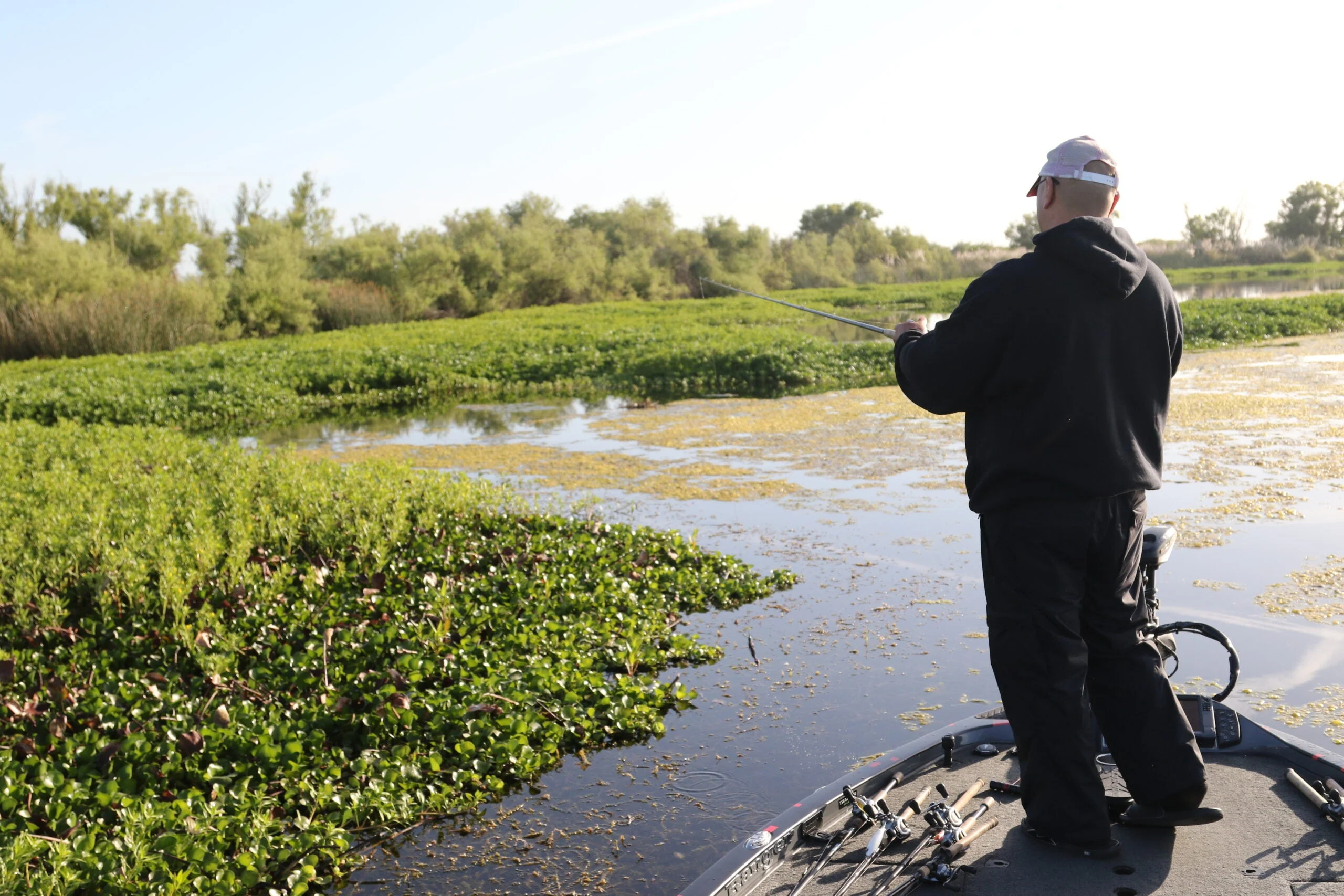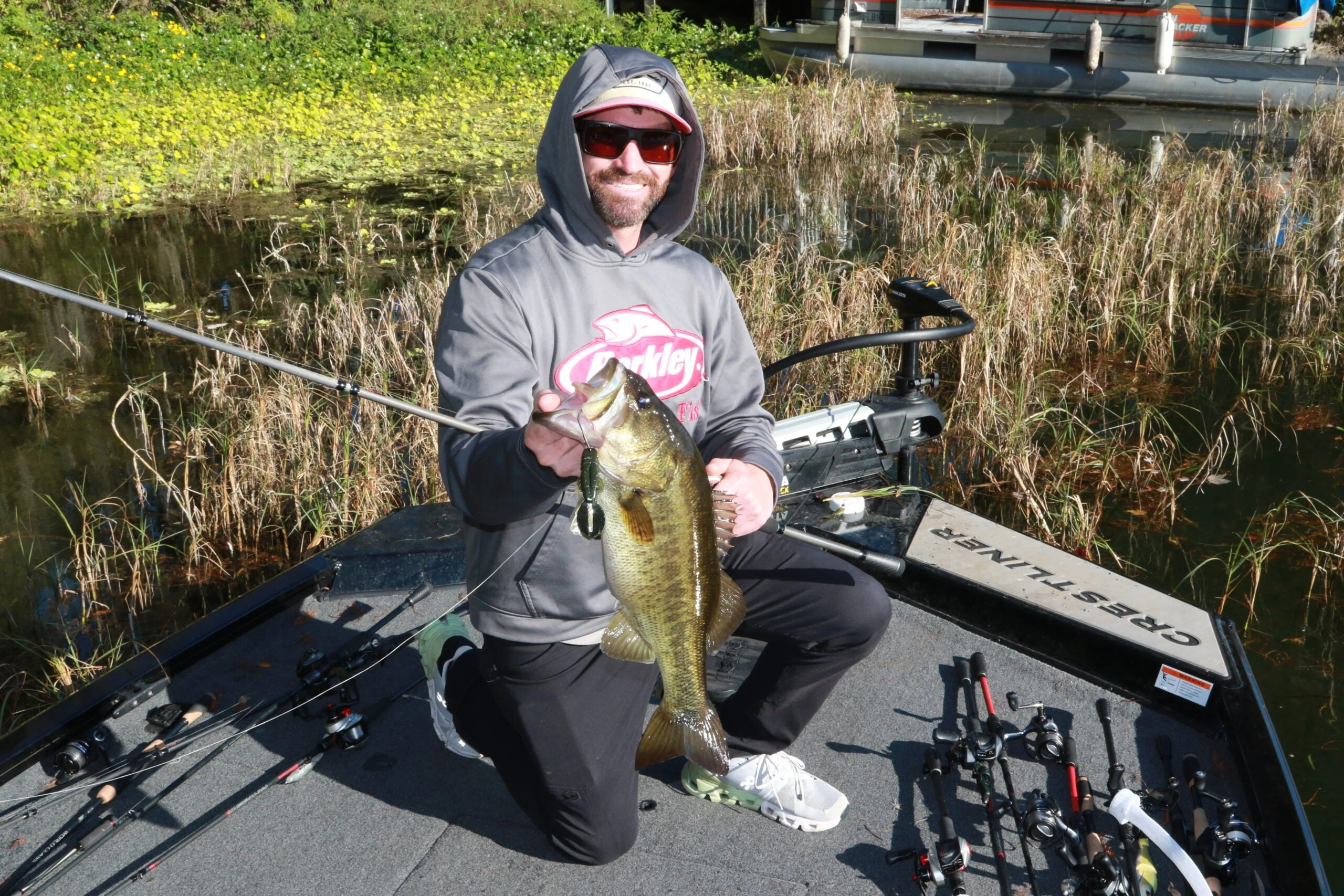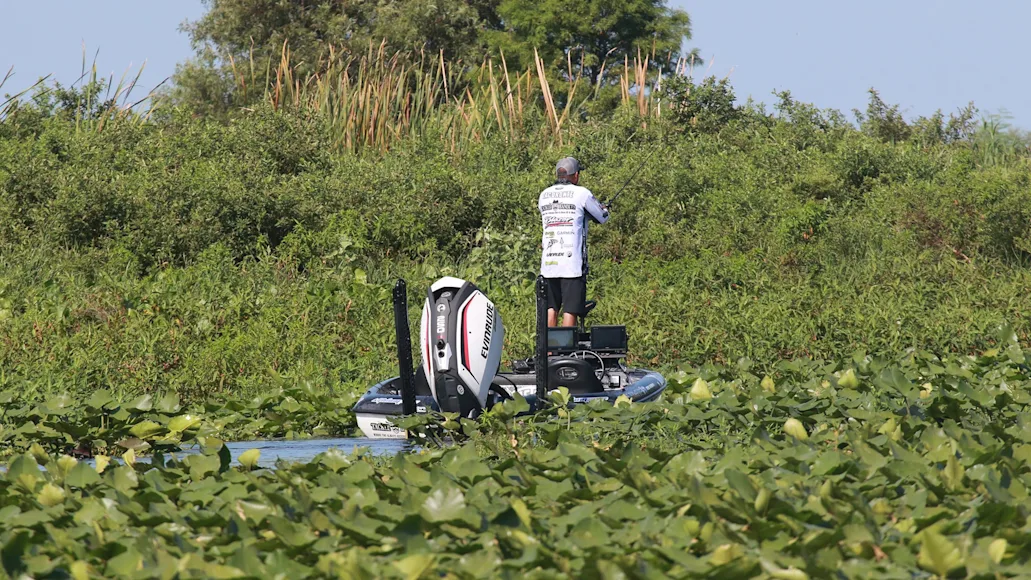_We may earn revenue from the products available on this page and participate in affiliate programs. Learn more ›
_
Anglers faced with the challenge of reaching summer bass sheltering beneath thick cover typically turn to punching—the act of driving a Texas-rigged soft-plastic bait through dense vegetation with a heavy weight. This technique may seem like a simple, brute-force tactic, but it’s more nuanced than many anglers think. Deciding which mats to target, where exactly to put your bait, which bait to use, and how to work it can all make a big difference in terms of how many bass you pull from the grass. Here’s a full breakdown for how to maximize your success.

Learn how to get the all-new Field & Stream journal!
Where and When to Punch Baits for Bass
By midsummer, when your favorite bass lake becomes hemmed in or even half covered with mats of thick vegetation, it can be hard to even know where to start. So, here is a list of tips for narrowing down the best places to punch a bait through the covering and find eager bass beneath:
Find the Floaters
Grass mats—mostly hydrilla, but also milfoil—can become pretty dense by summertime, so keep watch for areas where blown-in floating vegetation such as hyacinth or pennywort block the growth and create bass-friendly caverns below. Similarly, laydowns and rocks also create openings in the growth where bass like to hang out, so punch the lighter stuff around their perimeters.
Search for Sweet Spots

Look for irregularities in the cover, where a bass can dash out from under the weeds to grab your bait. David A. Brown
Look for mat irregularities, such as points, cuts, edges, and dips; these create sweet spots where fish can hold in cooler concealment and quickly dash out to grab easy meals. Look for isolated mats, too; a lone grass mat or floating mat tucked in the back of a cove, pocket, or canal, for example, will be a magnet for any bass in the area, so do not overlook such gems. With open-water grass mats growing on high spots, pay attention to wind speed and direction. Often, bass will stack along the windward edges to capitalize on wind-driven forage opportunities.
Watch the Rise and Fall
Tidal fisheries require an extra level of awareness, as the tides daily ebb and flow not only moves food past heavy cover and triggers brief periods of intense feeding, it also impacts fish positioning. On high water, bass can push deeper into a mat, but falling water drains the cover, compacts the vegetation, and pushes bass to the outer portions.
Remember That the Spray Is in Play
While anglers lament local agencies spraying prime bass cover with herbicides, a brown, dying raft of hyacinth or pennywort typically offers an unseen opportunity well worth some punching attention. When the plants die, crawfish gorge on the decaying plant matter, and bass are quick to capitalize on the concentrated crustacean buffet. So don’t pass these spots up.
Punch Post-Front Pads
In some weedy lakes, new grass growth may not yet be topped out, but pads interspersed with other weeds—vertical reeds or blown-in plants—offer ideal sanctuaries where bass will wait out the high pressure and bright sunlight of post-frontal “bluebird” days. Feeding may not be top priority, but like the offerings in a waiting room vending machine, if you’re bait is right there, it’ll probably get eaten.
**Related: Summer Bass Fishing: A Complete Guide
**
Best Baits for Punching

Punch baits are, in essence, Texas-rigged soft plastics with enough weight to get through this grass cover. David A. Brown
, and the venerable beaver-style bait
(narrow nose, broad ribbed body, flat tail, and various smaller appendages) handle the majority of the action. While the standard stuff gets plenty of business, you can also close the deal with a few other options. Stick worms
slip through cover better than anything and can work well at times, but if you want a little more action to trigger lethargic fish, try punching a ribbon-tail worm
.
Whatever your bait choice, a stout 4/0-5/0 straight-shank flipping hook is a must. If you’re missing too many bites, snelling your hook might improve your efficiency. At the moment of truth, that heavy weight often pops a fish’s mouth open and with the straight pull of a standard Palomar knot, your hook might miss the connection. With a snelled hook, pulling against that big weight snaps the hook upward at a nearly 90-degree angle. Some believe this increases the chances of hooking the fish. So, if you’re missing fish, give a try.
It can be a good idea to peg your weight with a bobber stop or a rubber peg. Some anglers opt for adding a punch skirt to help the bait slide through cover where it will then flare and create a larger profile. The biggest consideration, though, is weight size. The rule of thumb says to use the lightest weight that allows your bait to penetrate the cover with minimal effort. That could be a 3/4- to 1 1/2-ounce weight, but if it takes 2 1/2 ounces, so be it.
How to Work a Punch Bait for More Bites

A nice largemouth taken by punching the heavy cover in the background. David A. Brown
Once the bait breaches the cover, let it drop freely, as most of your bites will happen on the fall. We tend to use the term “reaction bait” for faster-moving lures—crankbaits, bladed jigs, spinnerbaits, frogs—but when a heavy object suddenly crashes through the roof, bass respond with a straight-up reaction bite.
If you get no immediately responds, hop the bait once or twice and then move to your next shot. The only exception is those sprayed mats. With bass likely picking crawfish from the mat’s underside, savvy anglers pull their punch bait next to the mat and wiggle it, or bump it against the vegetation to mimic a crustacean meal.
Now, if the cover’s super thick, but you know there’s sufficient depth to support bass below, you’ll benefit from accelerated bait speed. The technique is called “crashing,” and it simply a matter of increasing a bait’s velocity by swinging the rig about a rod length into the air and then letting it fall (crash) into the cover. A rapid downstroke with the rod tip adds an extra burst for the thickest cover.
**Related: The Best Summer Bass Lures—Picked by the Pros
**
Best Tackle for the Punching
When selecting a punching rod, consider that you’ll often make long reaches, you need enough “tip” to load up and propel your pitch, and you need serious backbone to winch a big fish out of heavy cover. A 7-foot, 6-inch to 7-foot, 10-inch heavy- to extra-heavy-action stick with a moderate tip does the job.
As for the reel, you may be surprised that experienced punchers often prefer a high-speed reel—something in the 7.4:1 to 8:1 range. There was a day when increasing speed meant a major sacrifice on power, but modern reels are packing more, well, punch, even at the higher gear ratios. Moreover, considering punching’s inherently repetitious nature, speed equals efficiency. The more in-and-outs you accomplish in a day, the greater your chances of landing in front of a mean one.
Flippers favor heavy fluorocarbon around wood cover because it doesn’t pinch into tight spots like braid. The latter, however, gives you the best chance of pulling a big fish through twice its body weight in soggy vegetation. Here’s a subtlety worth noting: Most braid manufacturers offer 4-carrier (strand) and 8-carrier lines. Both work for punching applications, but a 4-carrier line presents a rougher surface, as the process wraps a lower number of larger strands, as compared to the smoother finish created by wrapping eight smaller strands. In the thickest of punching cover, that rough surface saws through vegetation better and gets your fish out of the salad quicker.

